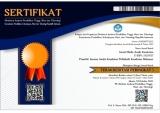Banana Tree Midrip Sap as an Antibacterial Staphylococcus aureus in Preventing Infection on External Wounds
DOI:
https://doi.org/10.32382/jmak.v14i2.281Kata Kunci:
Antibacterial, Kepok Banana Tree Midrib Sap, Staphylococcus aureus, WoundsAbstrak
Wounds are damage to tissue continuity due to trauma from sharp or blunt objects, changes in temperature, chemistry, electricity, radiation, or animal bites. Wounds that are not handled properly can easily become infected, which can be caused by bacteria, one of which is Staphylococcus aureus. This study aims to determine the effectiveness of banana tree midrib sap as an antibacterial Staphylococcus aureus in preventing infection in external wounds. The research design used was experimental with a Completely Randomized Design (CRD) with a post test only control group design pattern. The research samples consisted of kepok banana tree midrib sap and Staphylococcus aureus bacterial culture using an accidental sampling technique. The antibacterial test method uses the well method by measuring the diameter of the clear zone on the media. The data collected was analyzed statistically using the Kruskal Wallis test and continued with the Post Hoc Kruskal Wallis test with a confidence level of 95%. The results showed that the sap of the banana tree midrib showed an influence on the Staphylococcus aureus bacteria with a value of sig. 0.01 (α<0.05). Banana tree sap (Musa Paradisiaca L) has an effect at concentrations of 15%, 30% and 60% on Staphylococcus aureus bacteria. These results are in accordance with the results of the qualitative phytochemical test of Kepok banana tree midrib sap which contains alkaloids, saponins, flavonoids and tannins which function as antibacterials. The conclusion of this research is that banana tree midrib sap has great potential as an antibacterial for Staphylocoocus aureus in preventing infections in external wounds
Referensi
Alafiah, D.T. (2015) Uji Aktivitas Antibakteri Ekstrak Etanol Pelepah Tanaman Pisang Ambon (Musa Paradisiaca) Terhadap Bakteri Escherichia Coli Atcc 11229 Dan Staphylococcus Aureus Atcc 6538 Secara In Vitro. Universitas Muhammadiyah Surakarta. Available at: https://eprints.ums.ac.id/39523/.
Amalina, A.N. (2019) Uji Aktivitas Antibakteri Ekstrak Etanol Bonggol, Batang Dan Pelepah Pisang Raja (Musa acuminata x Musa balbisiana) Terhadap Bakteri Staphilococcus aureus. Universitas Jendral Soedirman. Available at: https://repository.unsoed.ac.id/4947/.
Azizah, R. and Antarti, A.N. (2019) ‘Uji Aktivitas Antibakteri Ekstrak Dan Getah Pelepah Serta Bonggol Pisang Kepok Kuning (Musa paradisiaca Linn.) Terhadap Bakteri Pseudomonas aeruginosa dan Klebsiella pneumoniae Dengan Metode Difusi Agar’, JPSCR : Journal of Pharmaceutical Science and Clinical Research, 4(1), p. 29. Available at: https://doi.org/10.20961/jpscr.v4i1.26544.
Cahyaningtyas, F.D. et al. (2019) ‘Pemanfatan Ekstrak Biji Teratai Sebagai Bahan Aktif Antibakteri Untuk Pembuatan Hand Sanitizer’, Indonesian Chemistry and Application Journal, 3(1), p. 7. Available at: https://doi.org/10.26740/icaj.v3n1.p7-13.
Dewi, N.P. (2020) ‘Uji Kualitatif dan Kuantitatif Metabolit Sekunder Ekstrak Etanol Daun Awar-Awar (Ficus septica Burm.f) dengan Metode Spektrofotometer UV-VIS’, Acta Holistica Pharmaciana, 2(1), pp. 16–24.
Fadholah, A., Fatimah, S.A. and Syahidahalla, S.C. (2019) ‘( Musa paradisiaca L . ) dan Jarak Pagar ( Jathropha curcas L .) untuk Menyembuhkan Luka Pada Marmut ( Cavia porcellus )’, 3(1). Available at: https://ejournal.unida.gontor.ac.id/index.php/pharmasipha/article/view/3297.
Hajiriah, T.L. and Intan, P.K. (2019) ‘Uji Efektifitas Getah Jarak Pagar (Jatropha Curcas) Sebagai Obat Pengganti Antiseptik Kimia’, Jurnal Kependidikan: Jurnal Hasil Penelitian dan Kajian Kepustakaan di Bidang Pendidikan, Pengajaran dan Pembelajaran, 5(2), p. 141. Available at: https://doi.org/10.33394/jk.v5i2.1812.
Hastari, R. (2012) Uji Aktivitas Antibakteri Ekstrak Pelepah dan Batang Tanaman Pisang Ambon (Musa paradisiaca var.sapientum) terhadap Staphylococcus aureus. Laporan Hasil Karya Tulis Ilmiah Diajukan sebagai syarat untuk mengikuti ujian hasil Karya Tulis Ilmiah mahasiswa Pro.
Malo, G., Saputro, I.P. and Turang, R. (2019) ‘Sistem Pakar Diagnosis Penyakit Kulit Menggunakan Metode Certainty Factor’, Jurnal Ilmiah Realtech, 15(1), pp. 13–18. Available at: https://doi.org/10.52159/realtech.v15i1.76.
Martiyanto, K., Nugroho, D. and Kimia, J. (2016) ‘Isolasi Senyawa Bioaktif Dari Batang Pisang Ambon (musa paradisiaca var. sapientum) Sebagai Bahan Baku Antibakteri’, Indonesian Journal of Chemical Science, 5(3), pp. 206–210.
Nurhayati, L.S., Yahdiyani, N. and Hidayatulloh, A. (2020) ‘Perbandingan Pengujian Aktivitas Antibakteri Starter Yogurt dengan Metode Difusi Sumuran dan Metode Difusi Cakram’, Jurnal Teknologi Hasil
Unduhan
Diterbitkan
Terbitan
Bagian
PDF downloaded: 1107







